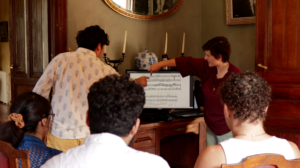Piano Lessons
Breathing New Life into Classical Music: Innovative Approaches to Engagement and Piano Teaching
Introduction
Classical music industry today is confronted with important questions that align with the concerns of classical music enthusiasts worldwide:
- Is classical music dying?
- What is the current state of classical music?
- How can we attract and engage audiences at classical music concerts?
- What can be done to make classical music a trending genre in today’s music landscape?
In an age where the music industry is saturated with myriad genres, classical music seems to be fighting a relentless battle to stay relevant. However, the world of classical music is undergoing a renaissance, with both prestigious international venues and innovative institutions like WKMT London embracing ground-breaking methods to engage audiences and revitalise the art of piano teaching. This article explores the most effective and innovative ways to make people fall in love with classical music all over again.
Immersive Concert Experiences
The classical music landscape is shifting towards immersive concert experiences that shatter the traditional barriers between performers and audiences. In world-renowned venues such as the Berlin Philharmonic and Sydney Opera House, concert-goers are encouraged to move around, capturing unique vantage points and interacting with the performers. The intimacy forged by this up-close and personal approach allows audiences to experience the emotional depth and raw beauty of classical music, fostering a deeper connection with the art form.
Merging Classical Music with Contemporary Art Forms
To capture the attention of younger generations and music lovers outside the classical sphere, concert organisers are increasingly combining classical music with contemporary art forms. This union creates a powerful synergy that transcends cultural boundaries and age groups. For example, performances featuring collaborations between orchestras and digital artists, such as the Los Angeles Philharmonic‘s partnership with the interactive media company Refik Anadol, provide audiences with a multi-sensory experience that marries classical music with cutting-edge technology.
Diverse and Inclusive Programming
In a bid to broaden the appeal of classical music, many institutions are incorporating diverse and inclusive programming. This approach showcases works by underrepresented composers, such as women and people of colour, and includes compositions that draw on a wide range of cultural influences. By featuring a more diverse repertoire, concert organisers are engaging new audiences and challenging the notion that classical music is an elitist and exclusive domain.
Outreach Programs and Community Engagement
Another key strategy in engaging people with classical music is the implementation of outreach programs and community engagement initiatives. These programs bring classical music to schools, hospitals, and other community spaces, making it accessible to a broader audience. By demystifying the art form and making it a part of everyday life, institutions can foster an early appreciation for classical music, and ensure its continued relevance for future generations.
WKMT London: A Pioneer in Innovative Piano Teaching
Nestled in the heart of the British capital, WKMT London has established itself as a leading institution for piano teaching. The school has embraced the innovative approaches discussed above to create a dynamic learning environment that captures the imagination of its students. One of the most notable elements of WKMT’s teaching methodology is its connection to the Scaramuzza technique. Developed by Argentine pianist Vincenzo Scaramuzza, this approach emphasises the importance of a natural and ergonomic technique, encouraging students to develop a deep understanding of their physical relationship with the instrument. By incorporating the Scaramuzza technique into their teaching, WKMT promotes a healthy, efficient, and expressive approach to piano playing.
In addition to its emphasis on technique, WKMT London has adopted the innovative strategies employed by international concert venues to engage its students and foster their passion for classical music. Students at WKMT have the opportunity to participate in immersive concerts, where they perform for one another and experience the power of classical music in a more intimate setting.
Furthermore, WKMT is committed to broadening the horizons of its students by exposing them to diverse and inclusive programming. The school incorporates works by composers from a variety of backgrounds into its curriculum, inspiring students to explore the rich tapestry of classical music and its many cultural influences.
Conclusion
The classical music world is experiencing a thrilling revival, as institutions and educators embrace innovative methods to engage audiences and revitalise piano teaching. By breaking down barriers between performers and listeners, merging classical music with contemporary art forms, promoting diverse and inclusive programming, and fostering community engagement through outreach initiatives, the classical music scene is reaching new heights of relevance and excitement.
At the forefront of this movement is WKMT London, where students are exposed to the latest innovations in piano teaching and classical music appreciation. By incorporating the Scaramuzza technique and emulating the strategies employed by prestigious international venues, WKMT is nurturing a new generation of pianists who are passionate, expressive, and deeply connected to the classical music tradition.
As we witness the continued evolution of the classical music landscape, it is clear that these innovative approaches are not only enriching the lives of those who participate, but also ensuring the longevity of this cherished art form. Through the efforts of institutions like WKMT London and the world’s most prestigious venues, classical music is poised to continue inspiring and captivating audiences for generations to come. In this exhilarating new era, the timeless beauty of classical music is being rediscovered, and its future has never looked brighter.



Pingback: Why You Shouldn't Use an App to Learn to Play Piano